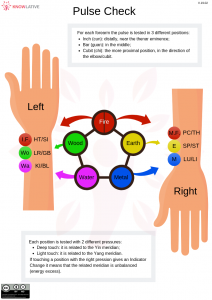Scope-Utility
In Chinese Medicine, pulse check is an important diagnostic tool. In muscle testing, pulse check is used to determine if there is an excess of energy in a meridian.
History
In Chinese Medicine the pulse of radial artery is checked in a much more articulated way than in Western Medicine and it is a very important tool for energy diagnosis.
For each forearm the pulse is felt in 3 different positions:
- Inch (cun): distally, near the thenar eminence;
- Bar (guan): in the middle;
- Cubit (chi): the more proximal position, in the direction of the elbow/cubit.
Each position:
- according to the side, is associated with an element and its meridians; in the left side (from elbow to thumb): Cubit corresponds to Water Element, Bar to Wood and Inch to Imperial Fire (Heart and Small Intestine). In the right side: Cubit corresponds to Ministerial Fire (Pericardium and Triple Heater), Bar to Earth and Inch to Metal (see picture);
- and it is tested at 3 different “depths”: superficial, middle, deep.
The analysis of the sphygmic pattern (the pression wave) related to the position where it is felt, give to the experienced Chinese doctor all the elements needed to make a “pulse” diagnosis.
In Muscle Response Testing (MRT) we normally use the same correspondences between position and element but we test each position/pulse at 2 different depths of touch:
- light: related to the Yang meridian;
- deep: related to the Yin meridian.
Technique
Test an Indicator Muscle (IM) holding the 3 positions of the pulse in the right arm and then in the left arm: a Muscle Change gives the side where there is an excess of energy.
Check the indicator muscle holding each of the 3 positions in the chosen side both with a light and with a deep touch. The indicator change gives the meridian (or meridians) with excess of energy.
To know which meridian have an excess of energy is essential in many balances in muscle response testing. Continue with your balance applying this information.

